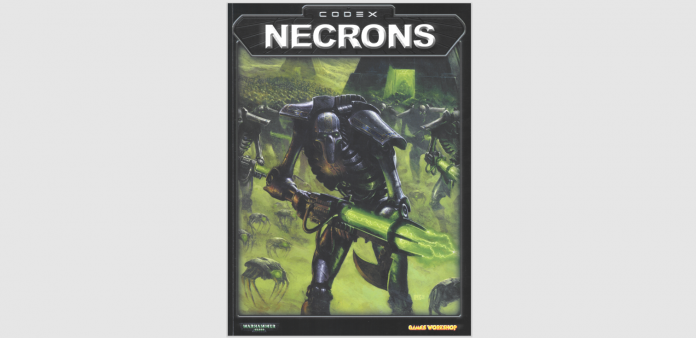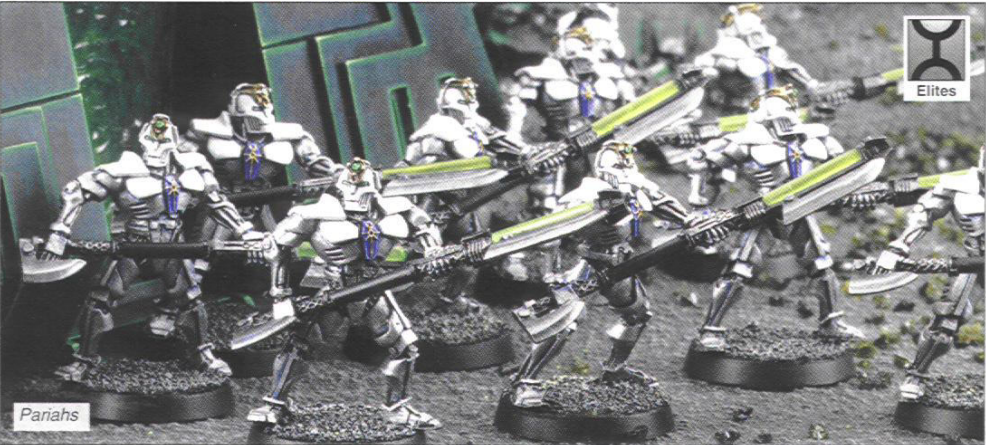Welcome to Goonhammer ‘02! We’re taking a look back to 20 years ago and some of the key releases of 2002. Today we’re talking about the release of the first ever Codex: Necrons and the impact it had on the 40k universe.
TheChirurgeon In July of 2002, Games Workshop released Codex: Necrons, taking the faction from an oddity supported only in issues of White Dwarf with a single-digit number of metal models to a full-fledged faction in the 40k universe. And in doing so, they added a terrifying new bogeyman to the setting, giving us a glimpse into a more cosmic horror that predated the Imperium by millions of years. While the release of Codex T’au the year before gave the setting a dose of bright optimism, Codex: Necrons gave us all a new thing to fear.
Codex: Necrons really stands out from the other books of the time. The short length, low unit count, and monochrome pages (all typical in 3rd Edition) added to the character of the Necron faction. Here was a race that the Imperium knew little about, had only encountered sporadically, and reviewing the available documentation was like scrolling through unorganized microfiche!
Mike: The Codex structure is pretty unique for its time or even now! There was a clear narrative drive and an attempt to create tension with the codex. As an introduction to a mostly mysterious new faction, the Codex reads like a thriller or a horror novel. Ignoring the book introduction, the first couple of pages include stories of guardsmen fighting horrifying skeletal xenos, inquisitors messing around with mysteriously glowing and growing asteroids, grim Eldar prophecies, and an overview of odd goings on in the galaxy. The “monsters” are then revealed with the army list but are still not given any sort of motivation or explanation. Finally, with the introduction of C’tan we’re given an explanation to the race’s origins and level of the threat. All throughout the Codex are snippets from a mysterious text, “Deus Ex Machina”, (that is never elaborated on) which hints at the galaxy wide implications that a reawakened C’tan may have. It’s all very Eldritch horror and it’s wonderful. The standout piece that really captured my young mind is the story of Adept Corteswain and it is a must read if you want to get a feel for what the Codex writers were going for with the faction at the time.
So, let’s strap on our explorator gear and dig into what made Codex: Necrons so special!
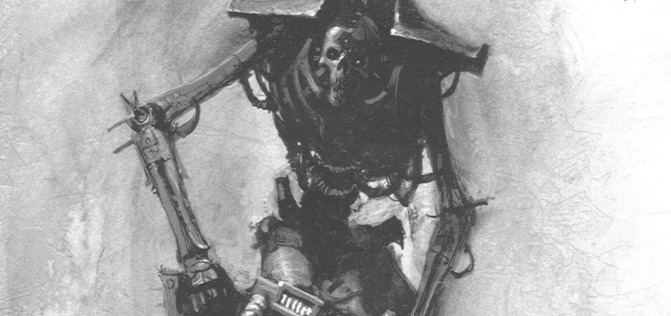
The Lore
TheChirurgeon: Necrons were originally introduced in White Dwarf as mysterious raiders, robots of unknown origin who would appear rising out of the ground or teleporting onto the battlefield, fight for an indeterminate period of time, repeatedly stand back up after being damaged, and then phase out via mysterious means.Their methods were inscrutable and their visages meant death. In their first Codex, GW chose to carry this thread forward, fleshing out the faction’s details and giving them an elaborate backstory that wound back millions of years.
As it turned out, the Necrons were the mechanical descendants of the Necrontyr, a technologically advanced but short-lived race whose planet was bathed in stellar radiation. In their early travels they encountered the preternaturally long-lived Old Ones and, setting with envy and contempt, started a war with the Old Ones that would nearly tear the galaxy asunder.
Although technologically advanced, the Necrontyr were no match for the Old Ones and their psychic progeny, the Eldar, and it was in their desperation that the Necrontyr discovered the existence of the C’Tan.

The Star Gods
Enter the C’Tan. In their study of the stars, Necrons discovered a series of curious anomalies in the oldest, dying stars. These anomalies were great beings that fed on the energy of the stars and the Necrontyr named them C’Tan, finding a way to communicate with them. Over time they were able to bind their essences into physical shells of living metal called a Necrodermis, and set them loose on their enemies.
The Necrontyr worshiped the C’Tan and in turn the C’Tan reveled in their worship. Eventually, they offered the Necrontyr immortality in the form of transference of their essences to machine bodies. In doing so, they became the Necrons, giving up everything except their undying hatred of the living, to serve the star gods silently for all eternity.
With their newfound forces the Necrons conquered the galaxy. The Old Ones may have been masters of the immaterium but the C’Tan were the masters of the material realm. They harvested whole populations at will, feeding on them one after another, but never sated. As they dominated the galaxy, the C’Tan began to fight amongst themselves, feeding on each other until only a few remained.
Eventually the Old Ones grew desperate and began creating and cultivating new races with a stronger link to the warp in order to fight off the C’Tan – the warp was anathema to them. These included the young eldar and later the Krork. They fought back against the C’Tan and their psychic energies with some success, so the C’Tan, now united against them once again, hatched a plan to stop them by cutting off the material world from the warp. But before they could finish, the psychic power of the young races created by the Old Ones began to spill over, warp rifts opened all over the place, and denizens of the warp – in particular, the Enslavers – began to spill out, feasting on the new races. This is what finally broke the Old Ones, who were scattered and defeated forever.
Rather than preside over a new, psyker-filled hellscape, the C’Tan instead chose to seal themself off in hidden tombs for millions of years, to emerge one day on a universe where all that mess had blown over. Then they could feast again.
In the third edition Codex, two of the C’Tan have emerged – the Deceiver being the first among them, a cruel trickster god who has been touring the galaxy. The other is the Nightbringer, released from his tomb by an idiot Ultramarine you may know by the name of Uriel Ventris. At least, in the original continuity. I have no idea how all that is meant to have gone down now. More on that in a bit.
The Pariah Gene
TheChirurgeon: One aspect of the C’Tans’ plan to cut off the immaterium was through the development of the Pariah gene, a genetic factor that makes someone a psychic “blank,” with no presence in the warp. To most people, these individuals are deeply disturbing, with vibes that are just very off. They’re immune to psychic activity, and find use even in the Imperium, where the Sisters of Silence are recruited from their ranks. Under the direction of the C’Tan, the Necrons actually track down and capture these individuals, converting them into cybernetic monsters called Pariahs that represent their ideal for the next step of life in the galaxy.
Mike: Shoutout to how big of a focus this was in the lore. The short story Shadow Wars is all about an Eldar Farseer’s hunt to destroy the Culexus Temple on an orphan planet. Pariahs are destined to usher in mankind’s enslavement to the C’tan as “gleaming traitors plucked from the imperfect womb of their race”. Good stuff.
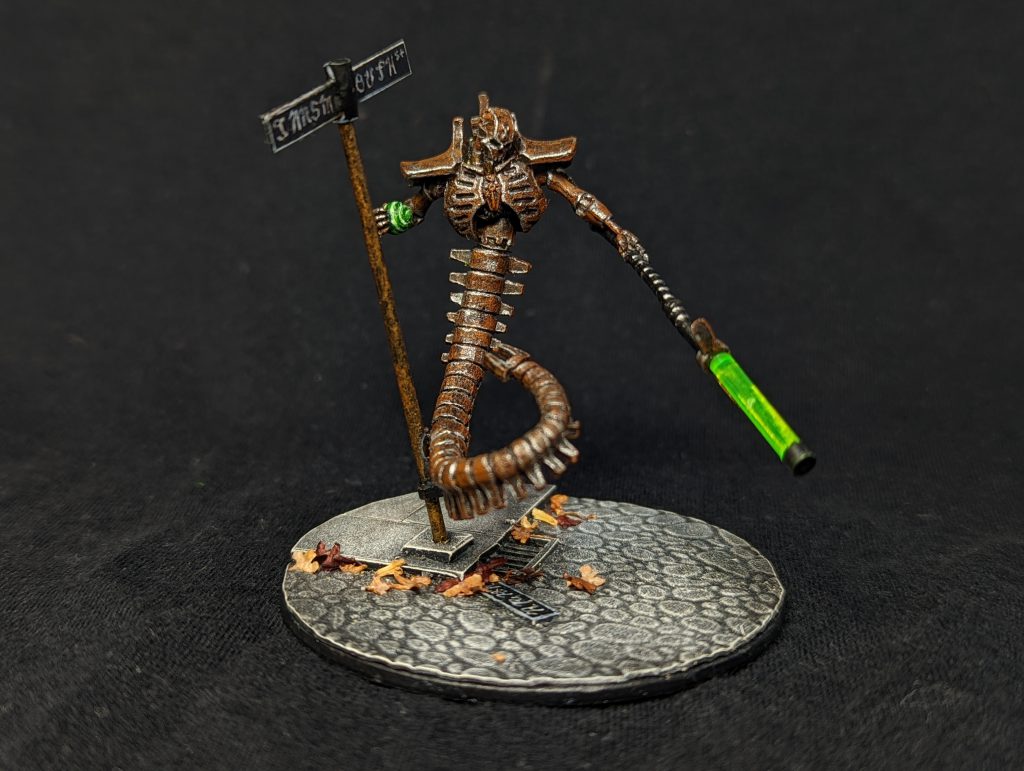
Silent Necrons vs. the Pharaohs
The Necron lore is one of the most interesting aspects of the 40k universe, in part because it’s one of the few areas where Games Workshop have completely reversed course on a faction and changed their backstory. In this original Codex, the Necrons are silent antagonists; largely grim, unflinching, soulless machines doing the bidding of inscrutable star gods. It’s the C’Tan here that are the characters – the only beings in the army capable of talking. And of those two, only the Deceiver actually does much of it – the Nightbringer is more like a force of nature. The C’Tan of the original fluff are eldritch horror, with horrifying means and motives unknown.
TheChirurgeon: Unfortunately, this makes it kind of difficult to write the Necrons as compelling villains, particularly when there’s already an army of inscrutable alien monsters out there who devour everything called the Tyranids. As much as I love the original lore for the Necrons, I completely understand why GW did a 180 on this – it’s really hard to do interesting stories with a race that’s can’t talk. The Necrons likely started as a rumination on how to do undead in space (Warhammer 40k has always been “fantasy in space” to some extent), and so it makes sense that on the redo in fifth edition they’d take a page out of the Tomb Kings for the second attempt. My only beef with that is that it comes at the expense of the C’Tan, who go from immense beings of power working behind the scenes to being just mindless weapons in the hands of the Necrons. The end result was that when the Void Dragon finally got a model in 2020, GW wrote almost no fluff on it – it just didn’t matter all that much anymore.
Mike: In a way GW actually addressed the antagonist problem in the Codex! Pages 60 & 61 include campaign ideas that provide motive for a Necron player’s army. It’s pretty generic stuff (the Red Harvest or Old Grudges) and still doesn’t necessarily help an individual player define their army but it’s an interesting touch.
Jettisoning the C’tan as the mysterious big baddies of the 3rd Edition 40K Universe is a bit of a bummer. Cold, cruel, and absolutely uncaring, they were the neutral evil of the 40k universe. They also really helped push the Eldritch horror angle. While the least Lovecraftian, the Deceiver liked to masquerade as Imperial governors and wax poetic about subjugating the human species The Nightbringer was released from an ancient tomb, killed a bunch of marines, and disappeared. The Outsider was lost on the edge of the galaxy and completely incomprehensible. The Void Dragon laid dormant on Mars, a ticking time bomb in the heart of the Imperium and, even more sinister, the evil seed from which the Adeptus Mechanicus sprung (allegedly)! There are also wonderful little hints about their millenia long influence on the galaxy… from the pariah gene, Mars’ Noctis Labyrinth, to a deep space Dyson Sphere. All of the younger races are blissfully unaware that their institutions rest right next to (or on top of!) something horrifying.
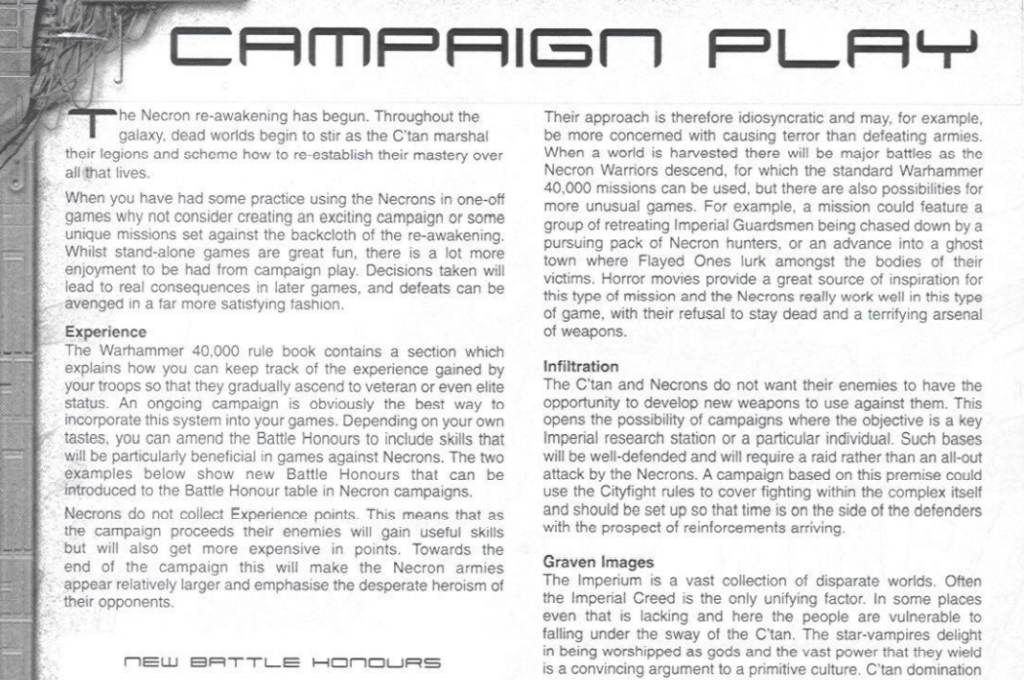
TheChirurgeon: Yeah the “Campaign Ideas” section at the end of the book is an oddity, even for 3rd edition codexes. The third edition rulebook had introduced some rules for playing campaigns and mission structures, and that got sparing support throughout the edition, with more showing up later on as supplements like Cityfight were released. It’s a cool section to have, and it feels more than a little like a stealth way to tie in the new faction to the then-nascent RPG, Inquisitor.
The Models
As befitting for a new, full faction, the Necron line was filled out with a number of new plastic kits, metal models, and metal-plastic hybrid kits, some of which are still around today. The Necrons’ unique model gimmick was that many models featured clear, green plastic rods designed to slot into their gauss weapons and warscythes.
- Metal Necron Lord
- Plastic-Metal Destroyer Lord
- Metal Pariahs
- Metal Immortals
- Metal Flayed Ones
- Plastic Warriors (Mike: complete with green clear rods… a first for Games Workshop (if you don’t count Eldar vehicle canopies)
- Metal Wraiths (Mike: the single best set of Necron minis ever, fight me)
- Plastic Destroyers
- Plastic Scarabs
- Metal Tomb Spyders
- Plastic/Metal Heavy Destroyers
- Plastic Monolith
- Metal C’tan – the Nightbringer and the Deceiver
Aesthetically, Necrons moved away from the chonkier, somewhat goofy minis of 2nd edition to a thinner, slicker, more alien look. The models still retained some of those faux-Egyptian/Tomb King flourishes while becoming more skeletal and stylized. The idea of modified Necron bodies also cropped up with Destroyers being essentially Immortals whose legs had been replaced with a large scarab-shaped hover platform and the new Wraiths getting the awesomely creepy whip bodies and long limbs (the original Wraiths more closely resembled the 9th edition Ophidian Destroyers). The new Pariahs diverged slightly from the overall aesthetic a bit (reflecting their fluff as hybrids), and the Monolith stuck with long flat panels rather than the slight-curves-with-hard-edges look that the rest of the line had.
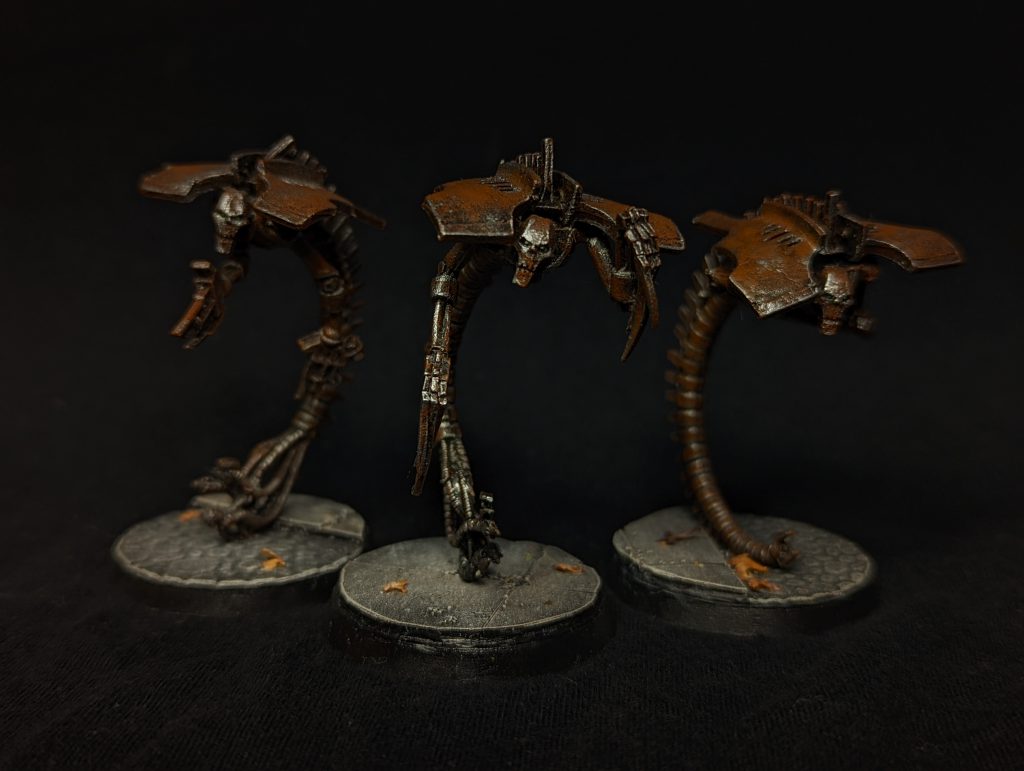
Mike: The line still holds up extremely well with many of the modern kits being simple refinements or plastic versions of the original run. The multiple part metal minis were… of their time. Heavy Destroyers would frequently lose their cannon mid-game and I have never had a Wraith that hasn’t lost one of its arms while in foam. Pinning the minis was near impossible due to the skinny limbs and rounded joints.
TheChirurgeon: Some of these models are still in use! Most specifically, the Destroyers and the C’Tan are the final holdovers here, with the former showing their age most severely thanks to the release of the Lokhust Heavy Destroyer. That’s not too shabby. Otherwise, the Necron range expanded again substantially in 5th edition when they got another overhaul and most of those models are still around.
The odd men out here are the Pariahs, the cybernetic hybrid psychic nulls converted into Necron service. These were basically the Necrons’ elite melee units and their models were pretty bad. They were quietly dropped in fifth edition when the Necrons got a new codex, replaced with Lychguard, who fill a similar role and have a somewhat similar aesthetic without being quite so chunky and out-of-place.
The Rules
Mike: Codex: Necrons liked to bend and break the rules. There were weapons that ignored invulnerable saves, deep-striking vehicles that avoided mishaps, units that completely ignored terrain, and equipment that allowed players to ignore even their own army’s rules. I’d argue that this all reinforced the Necron themes of otherworldliness and being beyond comprehension, while others might argue that this was all annoying…
We’ll Be Back
Mike: Taking its name from the army’s Terminator origins, We’ll Be Back (WBB) was the iconic Necron mechanic that allowed a killed Necron model to get back up. Essentially any model with the Necron Special rule that was killed in the last turn could rejoin an identical unit type within 6” on 4+ as long as it wasn’t killed by a power weapon equivalent or a weapon with Strength twice its Toughness (tying in with the old Instant Death rule). Staying in theme, there were a number of ways to ignore these exceptions including Resurrection Orbs (WBB even if killed by the aforementioned weapons), Tomb Spyders (rejoin units outside of 6”), and the Monolith Power Matrix (re-roll WBB for a transported unit). The Lords had their own exception where they didn’t need to be in range of another Lord. Coherency shenanigans abounded and I remember this rule needing a number of FAQs and clarifications!
Phase Out
TheChirurgeon: To reflect their nature as mysterious raiders, Necron armies mysteriously phase out when they’ve been properly decimated. As a Necron player you keep track of the number of Necron units in your army before the game starts – a total that does not include Scarabs, C’Tan, Tomb Spyders, Monoliths, or Pariahs – and then when you lose 75% or more of those, your army phases out and the game is over (you lose).
Mike: Hot take: Phase Out was cool. A Necron player would count up all of the models with the Necron Special Rule in their army. If, at the beginning of the Necron turn, only 25% or less of the models remained, the opponent would automatically win the game regardless of what scenario was being played.
OK, why is this cool? Necrons overall were pretty tough for their time. They were both incredibly resilient (see We’ll Be Back and all of the 3+ Saves) and could also bring a decent number of units to the table. Necrons points costs were on the mid-high side for a number of its units… especially the powerful ones. Also, you had to take a Lord and this unit could regularly push 200pts if you wanted them to be anything more than a Resurrection Orb carrier. The three most expensive (and powerful) units in the Codex, the Monolith and the two C’tan were also not Necrons.
This means when building a list a Necron player had to seriously consider Phase Out a threat if they wanted to load up on heavy hitting units. One could argue that the mechanic led to the rise of the very boring Phalanx army (which spammed basically just Warriors with a Monolith as support) but the army wasn’t even particularly good… especially with Rhino Rush and an Assault-heavy meta.
Phase Out also led to some tense games where opponents would prioritize killing units that buffed WBB and where a win (or loss) would come down to a few lucky 4+ rolls. Is this good game design? I don’t care, I had fun!
TheChirurgeon: I remain… unconvinced. All this did in my mind was disincentivize you from taking the army’s coolest units, i.e. Monoliths and C’Tan. I also never felt that Necrons were appropriately costed to take this into account – they could have been a little cheaper.
Gauss Weapons
TheChirurgeon: One more thing to note is that while Necrons were pretty light on heavy weapons, they tended to make up for it with Gauss weapons, the basic armament of their Warriors and Immortals. For Gauss weapons, any wound roll of a 6 automatically caused a wound regardless of Toughness (there used to be a much more complicated strength-vs-toughness table), and would automatically cause a glancing hit on a vehicle. This made Warriors and Immortals particularly dangerous against vehicles, as they could easily get 1-3 lucky glancing hits off on a vehicle firing as a full unit, keeping it stunned/shaken or going after heavier targets.
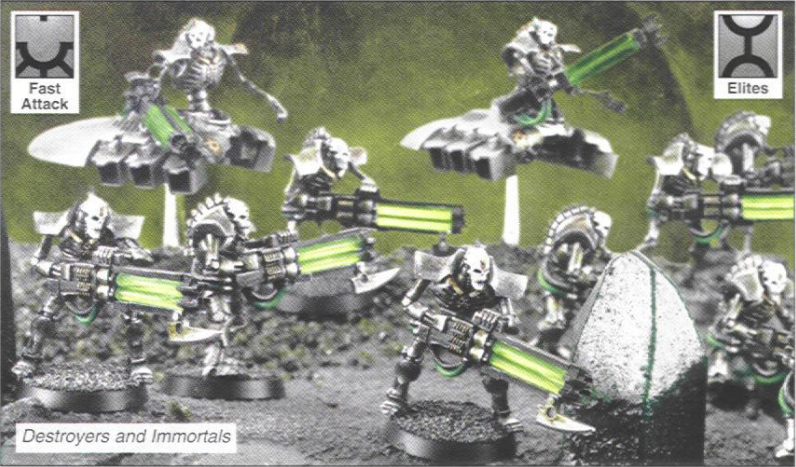
The Units
TheChirurgeon: The Necron army list got a complete overhaul at this point, more than tripling the size of the army and turning them into a real force. Previously, the Necrons only had 5 metal unit options: Lords, Scarabs, Warriors, Immortals, and Destroyers, and the models for these were… not GW’s best work, let’s say. They had a very 2nd edition aesthetic, particularly the Destroyer, which was just a Necron on a flying sled. The new release saw every one of those replaced.
Mike: Profile-wise, Necron units tend to look like marines from a profile standpoint, albeit slower (with Initiative 2), and with higher Leadership (10). At this early point even Necron Warriors had a 3+ armor save, something that would go away later as the army’s basic troops dropped to a 4+.Still, these were some beefy robots!
Necron Lord
The only non-C’tan HQ selection in the Codex and the only unit that could take wargear (aside from Disruption Fields). They were essentially a mandatory selection acting as midfield support for all of the other Necron units. The Lord was slightly beefier than many HQs of the time and could get buffed with the Destroyer Body as an upgrade (T6 baby!). They were also Initiative 4 so while they’d normally not swing first against most dedicated combat units, they’d still get a few power weapon hits in. It was way too easy to max out on wargear with this unit. My favorite two builds were:
- Necron Lord – Veil of Darkness & Resurrection Orb; hanging with some Immortals
- Necron Lord – Destroyer Body, Phase Shifter, Warscythe; hanging with some Wraiths
TheChirurgeon: The wargear selection here was great, despite the fact that you could only arm one model with the stuff. A lot of the Necrons’ gear thematically focused on the ability to manipulate time, like the Chronometron, which helped with your fall back and sweeping advance actions to prevent your units from being overrun. The aforementioned Destroyer Body basically replaced your lord’s bottom half and made them a jetbike, while the Phase Shifter gave them a 4+ invulnerable save.
The lone upgrade for Warriors here is the Disruption Field, which gives every model’s melee attacks the Gauss rule, allowing them to automatically glance vehicles on a 6 to wound. That’s big when you consider that at the time S4 weapons couldn’t really harm most tanks and targets with T8+ or AV11+. With enough numbers, Necrons could absolutely take out vehicles with just their rank-and-file guys.
The two biggest stand-out pieces of wargear for lords however were the Resurrection Orb, which allowed you to ignore WBB restrictions for power and high-strength weapons, and the Veil of Darkness, which let you pick up a unit and move them around the table. Both were thematic and popular and are still key parts of the Necron armory. The Veil basically hasn’t changed in 20 years.
Mike: Hell yea, the Veil of Darkness was my favorite piece of wargear! The Lord and a joined unit can move via Deep Strike! They can even Deep Strike out of combat. Bouncing around the board with your crew of ten Immortals dishing out 20 S5 AP4 shots was a treat… until you inevitably mis-happed!
Pariahs
TheChirurgeon: Pariahs were humans with the pariah gene (psychic nulls) who had been captured by the Necrons and converted into cybernetic warriors.
Mike: So friggin neat. But also so friggin expensive! A Power Fist Terminator squad’s worst nightmare, the unit was Strength 5 and had Warscythes (that ignored invulnerable saves). They also had the neat Soulless ability making every enemy unit with 12” Ld 7. I suppose Psychic Abomination was cool but it rarely came up for me. Unfortunately Pariahs were slow, vulnerable (no WBB), not a Necron (Uh Oh, Phase Out!) and cost way too much for what they could do… especially considering that they shared the Elite Slot with the fantastic (but infinitely more boring) Immortals. Shame they got Phased Out (har, har)… would have loved to see how the unit would have evolved in further editions.
TheChirurgeon: Yeah As cool as the concept of being immune to psykers was, there just weren’t enough of them and they weren’t good enough to justify that as a reason to bring the unit. Even an Eldar army only had a couple of psykers. Even today, that particular struggle continues. On top of that, while conceptually cool, these guys had rough models and ultimately I think their eventual replacements – the Lychguard – are much better.
Immortals
Mike: Toughness 5 Necron Warriors with Strength 5, Assault 2 weapons. Pretty good!
Flayed Ones
Mike: Pretty meh although I adored them. Necron Warriors with Initiative 4 two attacks and some deployment & movement abilities. They could also scare CC opponents into hitting on 6’s but that never seemed to happen! Again, another Elite Slot unit competing with Immortals. Sadly, it would take gross bois 6 more editions to get the rules and models they deserve!
TheChirurgeon: It’s worth noting that the original Flayed Ones weren’t defective, messed-up Necrons (there was no fluff about the Necrons destroying C’Tan at this point, the reason for there being so few was that they most ate each other). Instead, they were just fast, deadly Necrons who scouted ahead and wore their victims’ skin to sow confusion and fear.
Warriors
Mike: The only Troop in the codex but a pretty solid one. Basically a more resilient Tactical Marine with Initiative 2. With no options aside from disruption fields and with the fact that each Necron army had to spend at least 360 points on these guys, you can see how some people thought the army was boring. Also despite their WBB save, they would get completely rolled over by any other squad that had a power weapon or two. However they could hang in a firefight and could even glance a vehicle to death pretty effectively, making them good Troops.
TheChirurgeon: These guys came in units of 10-20 but because of how WBB and Phase Out worked (the latter counted models), you usually wanted bigger units, which meant taking 40-60 of these guys, which could be up to 1200 points of your army.
Wraiths
TheChirurgeon: The original wraiths were basically what Ophidian Destroyers are now. These originals were wiry, snakelike, floating Necrons with nasty melee weapons who had a 3+ invulnerable save and could phase through solid matter. They were replaced in 5th edition with Canoptek Spyders before 9th gave us a visually similar option.
Mike: Codex: Necron’s Fast Attack options are disrespectful… they are so good! I could gush about Wraiths for hours. They had a small squad size but the 3++ save, the Strength 6, and the 18 ” Guaranteed threat range (with a capital G) were just top tier. They could threaten soft-back tanks (especially when rolling with a Destroyer Lord), munch up Devastator squads, and basically be a nuisance to any unit not forcing you to make a lot of saves. Even then, you had WBB! And if that failed you had a Monolith to reroll! Right, you had a Monolith, right?
Destroyers
Mike: Flying Marine bikes but with a phenomenally better Heavy Bolter. S6 Gauss weapons on a Jetbike platform could only mean that these dudes would become a staple of many Necron lists. They could also be taken in Squads of 5 which, along with their ability to stay at arms length and WBB, meant they were fairly survivable.
TheChirurgeon: These, along with the C’Tan, are the only models still around from the original codex and are in bad need of an update to match the new Lokhust heavy destroyer.
Scarab Swarms
Mike: A pretty standard swarm unit for the time… until you gave them disruption fields and proceeded to glance as many vehicles as you could!
TheChirurgeon: This was a significant change for the unit, which went from small, individual metal models to bases of swarms similar to rippers in 3rd edition. Previously, Scarabs would just explode in melee, damaging everything around them, and this was one of the Necrons’ primary ways to deal with vehicles. In 3rd they instead just gained disruption fields, with the idea that they’d now just glance a vehicle to death, stripping chunks off it.
Tomb Spyders
Mike: A support unit for your phalanx army. You could use the Spyder to escort Warrior Squads, shuffle models around, and even occasionally help out in a combat with some grunts. Unfortunately the Spyder was a bit too squishy to dedicated fire or a powerfist to be phenomenal.
TheChirurgeon: They used to be able to poop out Scarab swarms. These guys would eventually become the basis for the Canoptek concept and visual aesthetic.
Heavy Destroyers
Mike: Destroyers with shorter range Lascannons that could be taken in squads of three. Yes, they were awesome.
TheChirurgeon: These basically had lascannons and were the Necrons’ lone long-ranged anti-tank guns (though the Monolith had a 24” particle whip). They were also hateful models, with a long metal gun that housed two plastic rods connected to the shoulder of a destroyer. They became even more hateful in finecast, where the gun would basically never arrive straight.
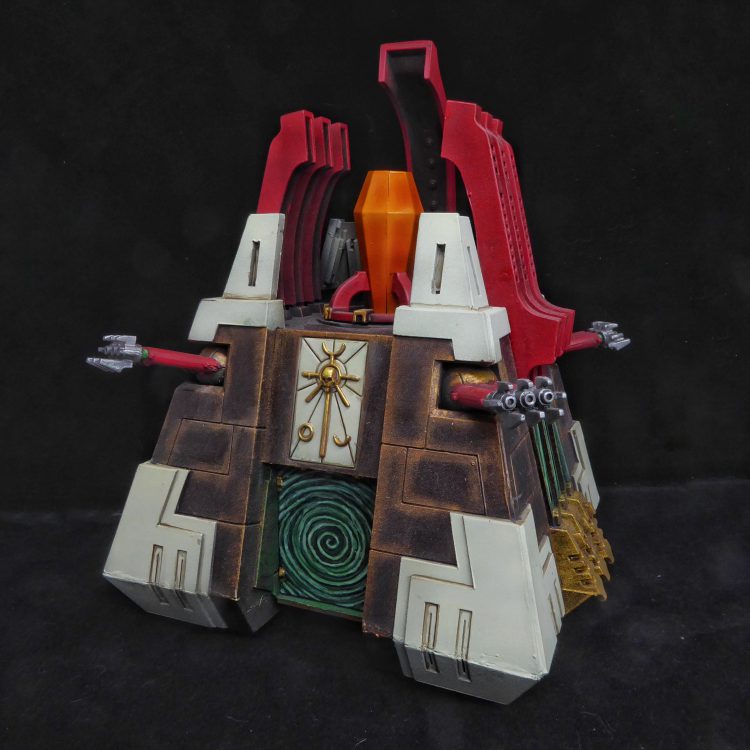
Monolith
TheChirurgeon: The Monolith was the lone Necron “Transport,” and was immediately the toughest unit in the game when it was released. It was very, very hard to kill.
Mike: Essentially a big, very chubby, middle finger to the core rules of the game. This Necron Land Raider could deep strike and ignore perils, ignore melta weapons & lances (before those were USRs), and wouldn’t crash (which would happen to immobilized skimmers). The Power Matrix was insane, not for the ability to toss out a better (short ranged) Battle Cannon shot but to teleport units back to the Monolith for another chance at WBB. Because of coherency issues it wouldn’t work with large blobs of Warriors but with every other Necron unit in the codex, it was a potential life saver! If the Monolith remained stationary it could also be used to slingshot units around the board using the Matrix. This made units with already impressive threat ranges (like Destroyers and Wraiths) all the more dangerous.
TheChirurgeon: My favorite bit was that part about how an immobilized monolith just drops to the ground quietly and doesn’t get destroyed. At 235 points, the Monolith was a steal.
The C’Tan – The Nightbringer and Deceiver
TheChirurgeon: The original rules incarnations of the C’Tan were some of the most powerful individual characters ever released. They were true monsters, meant to be dominating masters of the material realm. They were described as being able to warp reality around them to varying degrees in the text, saying “they can walk on air, pass through solid objects, and generally show off.”
Mike: They were absolute powerhouses and the first time we saw ‘god’ level (not just Greater Daemon) stats in 40k. They ignored all saves & terrain, S9+ and T8, 4+ invulnerables, and had options to leave Close Combat. Their special abilities were good and also gave the two units some character. Their two weaknesses were sniper weapons and their incredibly high points costs.
TheChirurgeon: Units had to pass a leadership test to even charge one, including marines. The Nightbringer was, as always, the more deadly of the two, with more attacks and a better WS, although it was slower (I4) than the Deceiver (I5). You took him to wreck stuff and use his lightning arc shooting attack (basically a 24” Lascannon shot). The Deceiver on the other hand was a nasty combat character in his own right but specialized in trickery, and his best trick was to allow the entire army the ability to redeploy its units before the first turn.
Final Thoughts
Mike: There so much more to gush about in Codex: Necrons… from the Painting and Color Scheme sections (someone at GW definitely wanted you to know that you could paint your robots in whatever color you wanted!) to the Tactics and Expanding Your Force sections to the nostalgia trip that is the guide to making foam crystal scatter terrain. Overall the real reason to revisit the Codex are the snippets of ominous lore and the fantastic grimdark art.
TheChirurgeon: This was a real fun blast from the past. I loved the Necrons’ fluff in this original version, and I was fascinated by the C’Tan. It’s been interesting to see the way GW went back and redid a lot of this a decade later – I get why they did it, even if I don’t like the new/current lore nearly as much. We certainly have better models now, and I’m hopeful that one day we’ll get new plastic Destroyers.
Have any questions or feedback? Drop us a note in the comments below or email us at contact@goonhammer.com.
